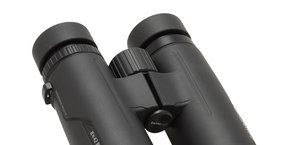Review of four 65 ED spotting scopes
4. Delta Optical Titanium 65ED – spotting scope review
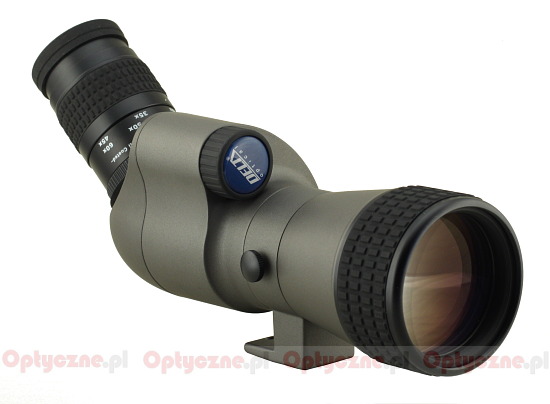 |
Design and build quality
The Delta Optical Titanium 65ED is the first spotting scope in the line-up of this Polish company. At once this piece of equipment landed among the top-of-the-range Delta devices marked by the Titanium symbol. We hope our test will show whether or not the new spotting scope deserves to be placed there.
Please Support UsIf you enjoy our reviews and articles, and you want us to continue our work please, support our website by donating through PayPal. The funds are going to be used for paying our editorial team, renting servers, and equipping our testing studio; only that way we will be able to continue providing you interesting content for free. |
- - - - - - - - - - - - - - - - - - - - - - - - - - - - - - - - - - - - - - - - - - - - - - - -
The Titanium 65ED is produced in China. Its origins can be traced back to 2008 when the PROMASTER Infinity Elite ELX 65 mm ED spotting scope appeared on the American market. When it comes to its exterior, it is surprisingly similar to the Delta – you can notice it in the photo below which presents the original Promaster.
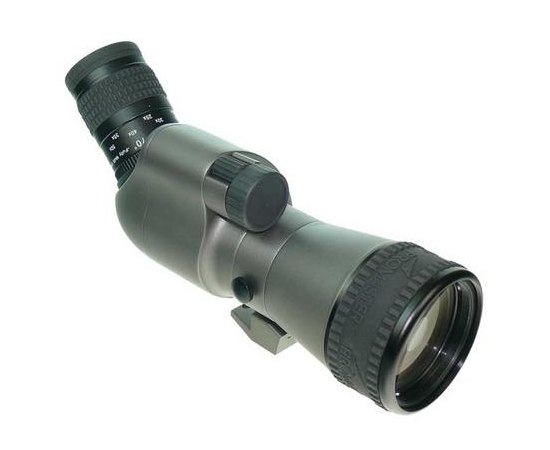 |
What’s interesting, the price of the Promaster was rather high – you had to pay 799 USD for it. The Delta’s debut price was 1249 PLN so significantly lower. Currently you have to pay 1190 PLN for it.
The Delta Optical Titanium 65ED appears to be the smallest spotting scope of this class on the market. It is shorter than the similarly small Pentax 65 ED-A but just slightly so. Undoubtedly its sturdy tube and a wide prism cell add to that impression of compactness. The producer boasts of magnesium alloys casing which is supposed to ensure solidity and a moderate weight. Indeed the scope is not heavy –it is physically ligher than the Celestron Regal and the Pentax 65 ED-A but still heavier than the Acuter.
The producer doesn’t provide any precise information concerning the optical construction of the offered device. One glance inside from the side of the objective lens allows you to determine that we deal here with a two groups system. You see five distinct reflections, one a bit weaker among them. It suggest there is a set of 3 elements positioned in two groups. One of the elements is made of low dispersion ED glass. Inside the tube there is also a focusing element (perhaps as a doublet achromat). Then we have Porro prisms behind which there is a prism directing the beam of light at an angle of 45 degrees to the axis of the lens. Then there is one more flat protective element.
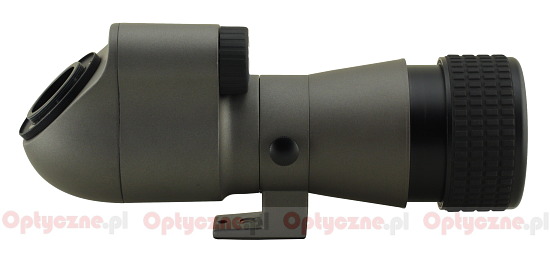 |
The spotting scope boasts a focal length of 370 mm which, with the objective lens’s diameter of 65 mm, gives us an aperture fastness of f/5.69. It means we have here the fastest piece of equipment of the whole testing group and the chromatic aberration might be often bothersome. The low-dispersion glass and a 3-element objective construction are really advisable. Exact parameters of the tested spotting scope are included in a chart below.
| Objective lens diameter: |
65 mm |
| Focal length: |
370 mm |
| Aperture: |
f/5.69 |
| Prisms: |
BaK-4/Porro |
| Optical construction: |
3-element objective lens with one ED lens |
| Dimensions (length × width): |
240 mm × 80 mm |
| Weight: |
925 grams |
| Price: |
1190 PLN |
The spotting scope start with an extendable dew shield, made of hard rubber. It extends by about two centimeters. As the element itself is hidden inside the casing, after the extension of the shield dew it is positioned about 3 centimeters deep.
Behind the dew shield you can find a narrowing tube, over 5 centimeters long. It turns into a tripod adapter ring. After loosening the blocking screw you can rotate the adapter every 45-degree stop. On it there is a three threaded ¼-inch holes which allow you to attach the adapter to a photographic tripod.
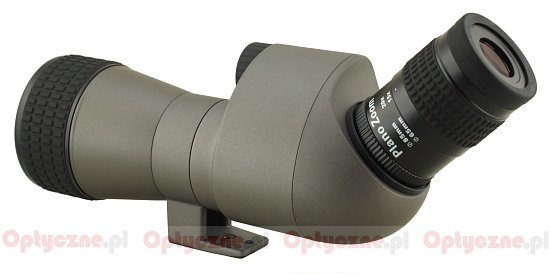 |
Immediately behind there is a quite wide and high prism casing. It is also made of metal, without any rubber armour. A short but wide focusing wheel (with a diameter of 32 mm) comes from it. Unfortunately it has just one gear ratio - a wheel allowing you to work with greater precision would came in handy. Fortunately the wheel works smoothly and is well-damped. Its big diameter ensures a satisfactory working precision.
The spotting scope ends with an extension tube which, at first glance, looks as if it was standard 1.25 inch one but in fact it isn’t. First of all the diameter of the hole you slide the eyepiece into is about 1-2 mm bigger than those 1.25 inches. That’s why standard eyepieces, when put into this tube, have some slack and move sideways a bit. What’s more, the bushing of the tube is threaded on the outside so the eyepiece which comes in the box with the spotting scope can be attached to it rigidly. A typical 1.25-inch eyepiece cannot be blocked in the extension tube though, because the Delta, unlike the Pentax or the Celestron, doesn’t have any clamp or tightening screw, typical for astronomical mounts.
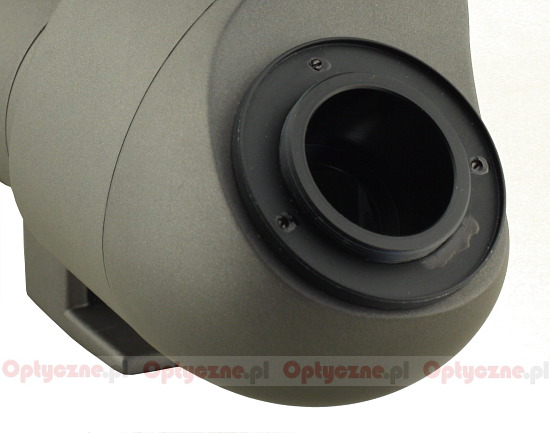 |
Still the 1.25-inch eyepieces can be used with the device – there is some slack but it isn’t very pronounced. However in some situations it might create additional off-axis aberrations. Apart from that a sudden tilt of the spotting scope might cause the eyepiece to slip out. The photo below shows the Delta Optical Titanium 65 ED with the Pentax XW 5 mm 1.25 inches eyepiece.
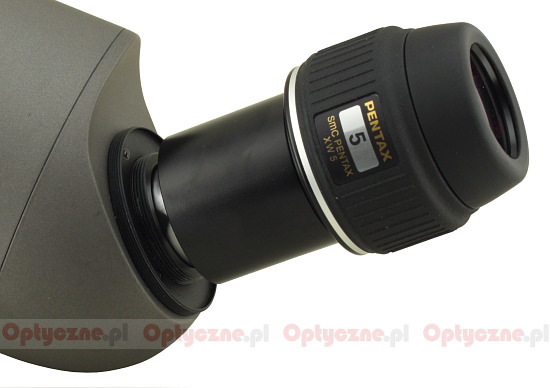 |
The image you see after looking into the inner tube is far from perfect. It is blackened very well but the paint could have been more matt. You can notice some ‘baffles’ to damp down the inner flares. The bottom near the prisms doesn’t look nice. It is gray, scratched and not blackened at all. There are some small specks of dust on the outer elements and prisms. It is typical - the Chinese factories have learned how to produce optics of good quality and quite solid casings but, unfortunately, they still lack a proper finishing and attention to detail. The Delta Optical Titanium 65ED is a very good example. Covering all the casing parts inside the tubes with black, matt paint is neither expensive nor time-consuming. In fact it is a really cheap way of improving the optical properties of the produced equipment and also winning favours with an inquisitive tester who cares enough to look inside with a torch.
The coatings, used here, are quite another matter. First of all their intensity, both for the light falling straight and at an angle, is very low. The Delta can easily compete here with SMC layers which cover the optics of the Pentax 65 ED-A. Additionally we don’t deal here with typical greenish MC coating, which are mass-produced by Chinese plants. The Delta coatings seem to be in different class - from the side of the objective they shine purple, pink, orange and dark green which might suggest different layers were put on different air-to-glass surfaces. On the prisms the coatings are blue-purple. The transmission of the Delta will certainly be higher than that of the Acuter or the Celestron, certainly without that unnerving dip in the centre of the visible spectrum.
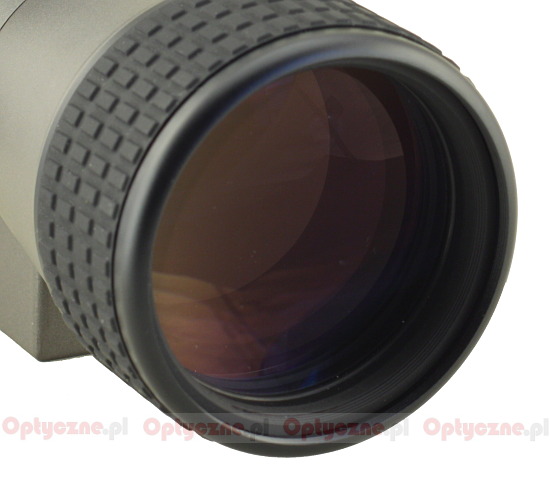 |
Eyepiece
Let’s start with the parameters of the eyepiece you get in the box with the Delta. It is a 8-24 mm construction which, because of a bit shorter focal length of the spotting scopes, provides the magnification range from 15.4 to 46.3 times. The range of the eyepiece’s fields of view is especially impressing. According to the info on the casing at the longest focal length the field is 50 degrees and at the shortest –70 degrees. It is really a great piece of news. Personally I simply hate fields of view on the level of 40 degrees because every time I use such a device I have an impression of looking through a keyhole or a very narrow tunnel and it irritates me to no end. When you deal with fields of view of 50 degrees and more there is no such a problem. Maybe it is caused by the fact that most of eyepieces, used in binoculars, and most of typical Plossl astronomical constructions, put into 1.25-inch casings, have fields of view on the level of 50 degrees so I am used to them.
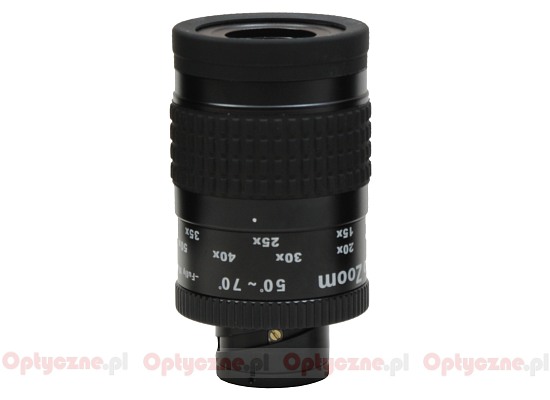 |
Such a range of fields of view is also a very good news for your purse. If I got a zoom 8-24 mm eyepiece in the box, featuring the fields of view from 40 to 60 degrees, I would immediately start looking for a 20-25 mm eyepiece with the apparent field of view of 55-65 degrees to get a comfortable magnification with a wide field. In the case of the Delta I don’t have to do that – a quite wide field is provided by the eyepiece you get in the box with the spotting scope.
With shorter focal lengths the situation is similar. Having a field of view on the level of 60 degrees near 8 mm focal length you can be tempted by some expensive 70-80 degrees eyepieces. Having a standard ‘zoom’ with a 70-degree field of view that temptation seems to be far weaker and savings in your pocket – noticeable.
After the Prominar and the Delta appeared on the market, some attentive readers have noticed that their eyepiece was similar to the Baader Hyperion 8-24 mm Clickstop-Zoom eyepiece, sold separately. The dimensions and parameters suggested we deal here with twins from the same factory. However we have found two facts which might indicate that the relationship between those two eyepieces might be not so close after all.
First the Baader Hyperion features a clickstop zoom mechanism and the Delta eyepiece – a twist-up. Secondly the Delta eyepiece could be inserted into the 1.25-inch extension tube of the Pentax 65 ED-A and cooperated with those rival spotting scopes without any problems. The Baader Hyperion 8-24 mm Clickstop-Zoom, dedicated for 1.25-inch extension tubes, fitted the Pentax tube as well but it didn’t want to focus to infinity. Objects situated in greater distances were always fuzzy. The Delta eyepiece didn’t perform like that.
The basic parameters of the tested eyepiece are presented in a chart below.
| Focal lengths range: |
8–24 mm |
| Field of view range: |
70–50 deg |
| Eye relief |
no data |
| Optical construction: |
5 grups/ 7 elements |
| Dimensions (length × diameter): |
98 mm × 54 mm |
| Weight: |
285 grams |
| Price: |
in the box |
The photo below shows a comparison between the dimensions of different 8-24 mm lenses, used in this test. They are as follows from the left: an eyepiece added to the Pentax, The Delta Optical Titanium, the Celestron Regal and the Acuter.
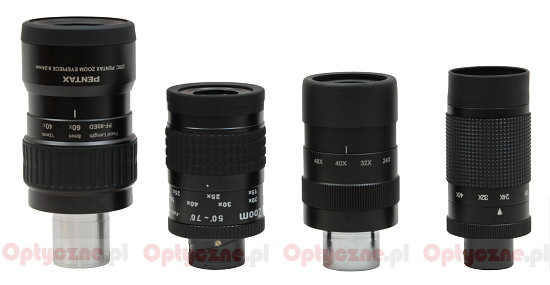 |
The Plano Zoom 8-24 mm, added to the Delta, is a relatively short but quite wide eyepiece. Its eye lens is 23 mm in diameter, surrounded by a rubberized eyecup with a smooth twist-up regulation (it can be extended to less than 1 cm). Immediately after the eyecup you meet a very wide zoom ring. It is 4 cm high and in the middle of it there are rubber ribs to enhance the comfort of work. The zooming is performed with the right smoothness and the ring is well-damped.
Behind the ring we get an immobile part of the casing with the magnification marks. What’s interesting they are given for two objective lens diameters: 65 mm and 85 mm which might suggest that the producer is going to launch a similar spotting scope but with an 85 mm objective lens.
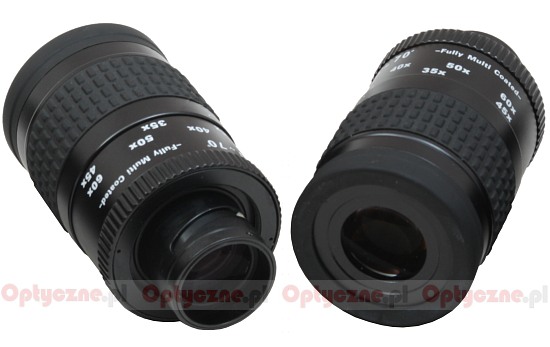 |
Further on we find a metal, ribbed ring, 8 mm wide, with an inner thread which is used to attach the eyepiece to the spotting scope. The front element set is positioned in a black bushing; it is 31 mm in diameter and almost 20 mm long. As the eye lens is immobile, the front element set changes its position. At the longest focal length it is hidden in the casing 12 mm deep and at 8 mm it is on the same level as the rim of the bushing.
The inscription on the eyepiece casing (Fully Multi Coated) suggests that all air-to-glass surfaces are covered by multilayer antireflection coatings. A minute inspection of the elements confirms it is really the case. You should praise the fact that also here better coatings that those greenish MC, used in Acuter and Celestron eyepieces, were used. The coatings produce less intensive reflections and sparkle with dark blue, green and purple.
Vignetting
Images below show the shape of the exit pupil at the minimum magnification and the appearance of the prisms, photographed within the eyepiece axis. In this case the vignetting amounts to 1.2% and so much light, diligently gathered by the objective lens, you lose at the very start.
| Exit pupil | Eyepiece tube |
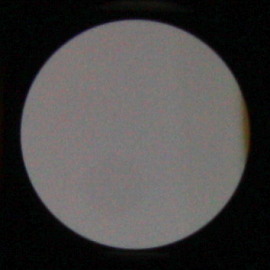
|
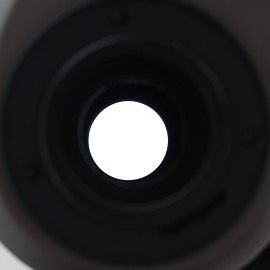
|
You would want to get here a perfectly circular exit pupil but it is not the case. To defend the Delta we can add that the loss of 1.2% of light is not something especially severe and in this category the Titanium still has the best result of all the tested devices.
Inner flares
The photos below present how the areas near the exit pupil look at the minimum and the maximum magnification.
| Power 15x | Power 45x |
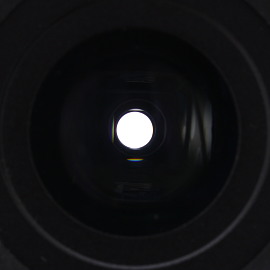
|
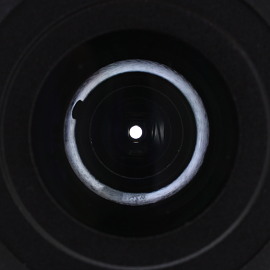
|
In this category we don’t have any reasons to complain. The area near the exit pupils is noticeably better than that of the Acuter or the Celestron. The only flaw is a distinct ring of quite significant diameter which surrounds the exit pupil at the maximum magnification. Fortunately its intensity is not especially high.
Chromatic aberration
The chromatic aberration was tested first on a chimney silhouetted against blue sky. At the smallest magnification in the field of view centre we didn’t manage to get an image completely free of that type of aberration – you could still notice slightly yellowish hue on the edges of the field. Here the Delta was a bit worse than e.g. the Celestron. For a change when we progressed to the field of view border, the purple-yellow rims were moderate and seemed less pronounced than in the Regal.
When it comes to the field of view centre the situation improves when you pass to the maximum magnification. In that case the chromatic aberration can’t be noticed at all. On the edge of the field we get distinct yellow colour, very similar than that of the Celestron.
Bright Venus at the maximum magnification looks decently well but only barely so. ‘Colours’ on the edge of its disc are less pronounced than in the Acuter but you can notice a distinct blue-red cast which the Celestron didn’t have. When it comes to the Moon it looks nice at 15x and the chromatic aberration is not bothersome there. In the centre you see just slight yellowish ring which becomes more intensive on the edge. At the maximum magnification there are almost no traces of chromatic aberration in the centre (minimum yellow). On the edge the situation is noticeably worse because you can see a distinct yellow-blue rim.
To sum up this category the performance of the Delta can be assessed as moderate. The aberration is not corrected perfectly well but it is also nothing that would be particularly disturbing. To defend the Delta a bit we must mention its short focal length and significant aperture fastness which make the task of chromatic aberration correction really difficult.
Astigmatism
At the minimum magnification the Delta seems the best of all the instruments, tested here, when it comes to the astigmatism correction. Its advantage over the Celestron remains very slight but it performs significantly better than the Acuter and the Pentax. At the maximum magnification it is the Celestron which leads - the image of the disc of Venus is sharper than the image provided by the Delta. Still the result of the Titanium is good here and the overall assessment of the astigmatism correction is very good.
Coma
At the minimum magnification the coma is visible already from a distance of 75% of the field of vision radius and on the very edge it gets to the borderline between values considered by us as medium and high. At the maximum magnification the results are a bit better but still they are far from perfect. The coma appears in the distance of 80% of the field of vision radius and on the very edge it is between low and medium. The Delta Optical Titanium fares here the worst of all the group of spotting scopes, tested here. To defend it a bit you could say that its weaker results might be caused by using an eyepiece with the widest field of view.
Distortion
At the lowest magnification we deal with slight pincushion distortion. Its level is just a bit higher than that of the Celestron and the Pentax. At the maximum magnification we still have some ‘pincushion’ and its level exceeds slightly that shown by the competitors.
Blur on the edge of the field
As the eyepiece of the Delta provides the widest field of view we were very curious about the results in this category. What’s interesting we weren’t disappointed. Applying 15x magnification we get a field which sharpness ends only in the distance of about 75-80% of the field of vision radius. Even a better result we get at 45x where as much as 90% of the field remain sharp. There are no serious reasons to complain here.
Accessories
The accessories you get when you buy the Delta Optical Titanium spotting scope are very interesting. We were positively impressed by an aluminum little case which allows you to move your equipment safely and without any problems. There is a lot of space inside – not only for the spotting scope itself but also for additional accessories which you might buy later. Additionally you get a functional protective case – you can carry your scope in it and/or conduct observations without taking it off. Its quality is worse than the case of the Pentax case but still it is a nice accessory.
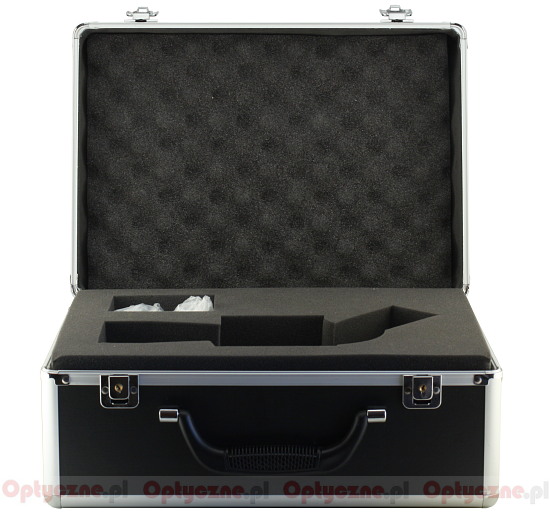 |
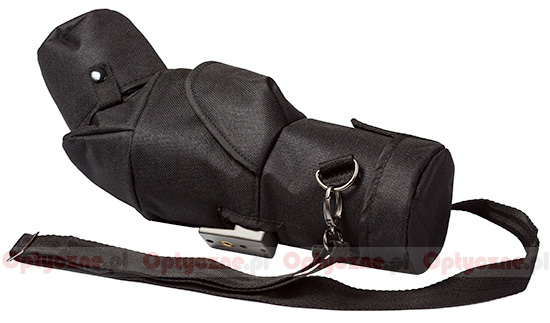 |
An photographic camera adapter can be bought optionally. The producer is also going to add a narrow ring for the eyepiece mount which will reduce the diameter of the hole and turns it into a proper 1.25-inch one. That last improvement really took our fancy – we think it is a great idea and we are waiting impatiently for its launch.
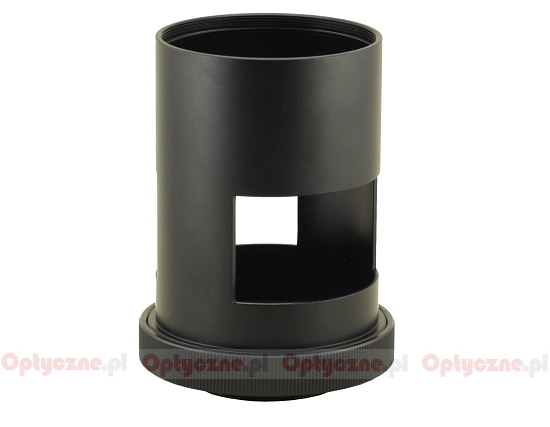 |
Summary
Pros:
- very tight, compact build,
- slight astigmatism,
- not very bothersome distortion,
- good sharpness in most of the field of view,
- high quality antireflection coatings,
- exit pupil on a relatively dark background,
- standard eyepiece with the best field of view of all the tested spotting scopes,
- little aluminum suitcase and a functional protective case added to the box,
- very good price/quality ratio.
Cons:
- noticeable coma.
The Delta Optical Titanium 65ED is a very handy, nifty spotting scope with good optical qualities and affordable price. If only the producer decided to use a standard 1.25-inch mount and a focusing wheel with double gear ratio we would get a perfect piece of equipment at this price point. As it is, we can complain a bit but it shouldn’t be too loud and it shouldn’t dominate our summary because it’s like picking holes. The Titanium 65ED is really a well-put-together instrument which can satisfy any amateur user who begins their observations adventure.
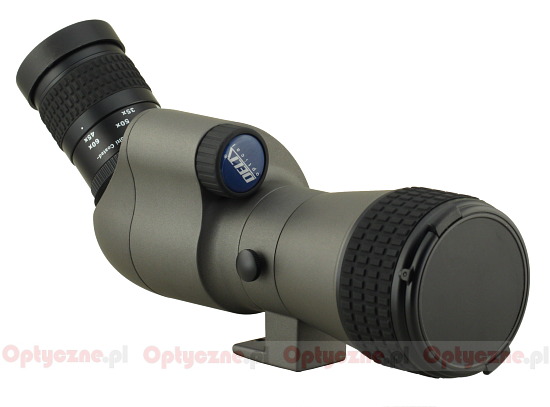 |






